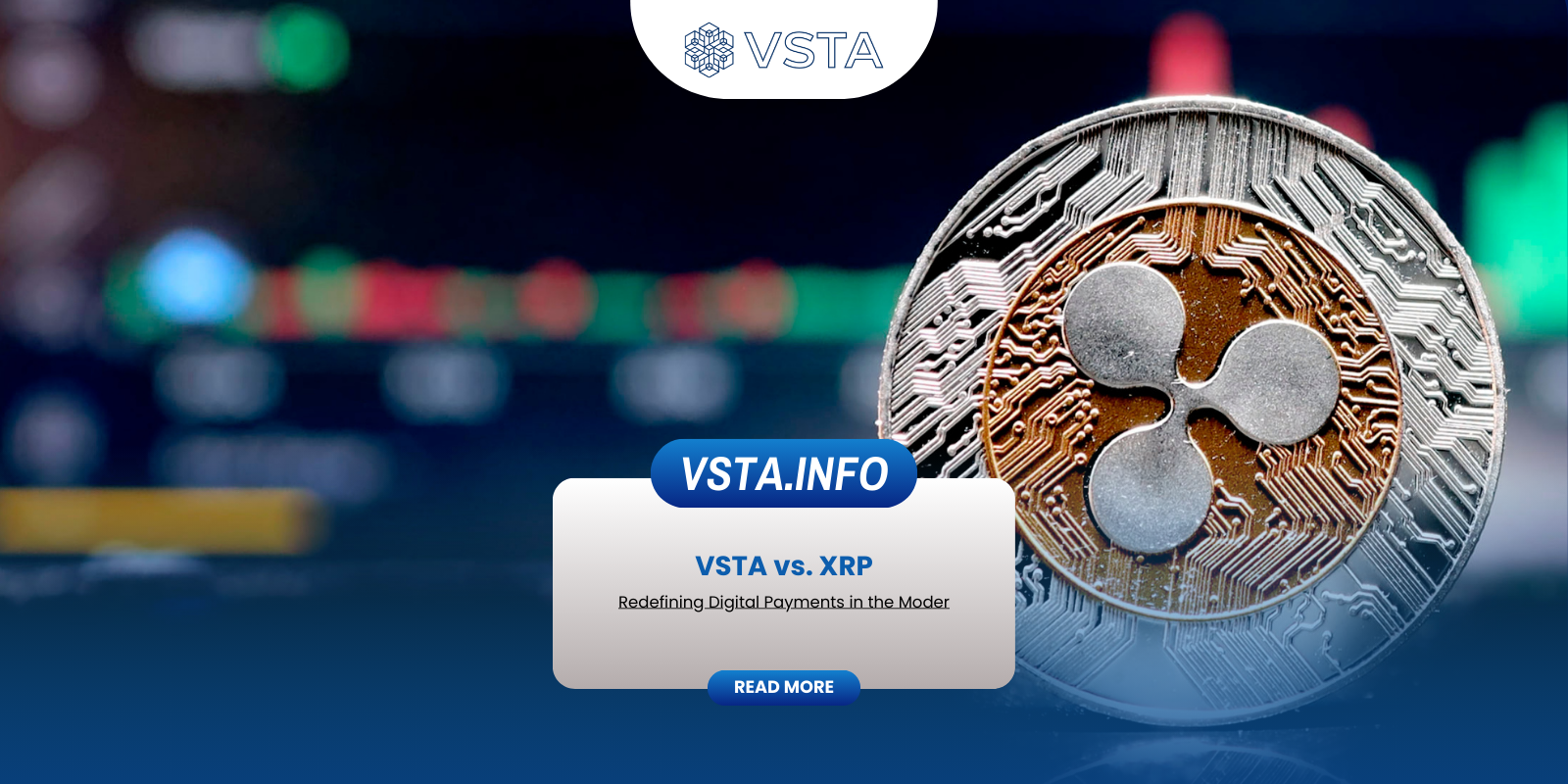In recent years, cryptocurrencies have reshaped how we think about global transactions. Among the most prominent players are XRP and VSTA, two innovative solutions targeting different sectors of the digital economy. XRP has long been recognized for its cross-border payment efficiency, while VSTA introduces a new frontier by combining AI and blockchain technology. By taking a closer look, it becomes evident why VSTA is gaining attention as a game-changer in digital payments.
“Compare VSTA and XRP – which token offers the best digital payment solution? Explore their applications and real-world benefits.”
Vision and Objectives
XRP:
Ripple Labs developed XRP to simplify international bank transactions. Through its XRP Ledger, payments are processed at lower costs and higher speeds. A prime example is how banks in Europe use XRP for seamless currency exchanges with Asian counterparts, eliminating delays and inefficiencie

VSTA:
VSTA’s mission is broader, aiming to create a flexible payment solution for industries like entertainment, retail, and decentralized finance (DeFi). For instance, a gaming company can use VSTA to provide instant, cost-effective transactions to players worldwide, enhancing their experience.
Key Difference:
- XRP is optimized for banking sectors.
- VSTA expands to diverse industries, leveraging AI to improve risk management and scalability.
Core Technology
Here’s how XRP and VSTA compare in terms of technology:
| Feature | XRP | VSTA |
| Blockchain | XRP Ledger with Ripple consensus algorithm | Decentralized blockchain with smart contracts |
| Transaction Speed | 3-5 seconds | 1-3 seconds |
| Throughput (TPS) | ~1,500 TPS | ~10,000 TPS |
| Transaction Fees | Minimal (~0.00001 XRP) | Almost zero |
| Security | Bank-grade encryption | Advanced AES-256 with AI risk detection |
Takeaway: While XRP is designed for financial institutions, VSTA’s advanced AI-enhanced blockchain offers flexibility and speed, making it ideal for high-demand environments such as e-commerce platforms.
Real-World Applications
Alt text: Real-world use cases for XRP and VSTA.
XRP:
- Cross-Border Transactions: Enables financial institutions to transfer funds internationally without traditional delays. For example, a bank in India can send payments to Europe in a few seconds using XRP.
- RippleNet Integration: XRP powers RippleNet’s On-Demand Liquidity (ODL), helping businesses manage cash flow effectively.
VSTA:
- Entertainment Payments: Streaming services and gaming platforms benefit from instant, secure transactions using VSTA.
- Global E-commerce: Online stores can rely on VSTA to reduce fees and improve customer trust through transparent blockchain-based payments.
- DeFi Tools: VSTA supports staking and peer-to-peer trading, making it a strong player in decentralized finance.
Key Difference:
- XRP concentrates on banking partnerships, whereas VSTA addresses a wider market, from small businesses to individual consumers.
Investor Benefits
Alt text: Investor benefits comparison of XRP and VSTA.
XRP:
- Stability: XRP’s established reputation offers confidence to institutional investors.
- Sustainability: Its low energy requirements align with environmentally conscious financial systems.
- Liquidity Management: RippleNet ensures steady liquidity for cross-border operations.
VSTA:
- Lucrative Staking Opportunities: VSTA holders enjoy high APY rewards, sometimes exceeding 150%, making it appealing for long-term investments.
- Democratic Governance: Token holders influence platform changes, ensuring community involvement.
- Multi-Industry Versatility: Its use cases span entertainment, retail, and DeFi, making it a well-rounded investment.
Highlight: Investors seeking stability may lean towards XRP, but VSTA’s potential for high returns and diverse applications attracts forward-thinking stakeholders.
Development Roadmap
Alt text: XRP and VSTA development timelines.
XRP:
Ripple plans to deepen its collaborations with banks worldwide. However, regulatory challenges in markets like the U.S. could slow its momentum.
VSTA:
- Upcoming Innovations: Between 2024 and 2028, VSTA aims to expand DeFi capabilities, introduce more dApps, and partner with major exchanges.
- AI Evolution: Continuous development in AI ensures VSTA remains a step ahead in offering user-centric payment solutions.
Perspective: XRP focuses on refining its role in banking, while VSTA prioritizes disruptive innovation, targeting broader audiences and industries.
Environmental Impact
Alt text: Eco-friendly blockchain technologies: XRP and VSTA.
XRP:
Ripple’s architecture avoids energy-intensive mining, making it an eco-friendly option compared to Bitcoin.
VSTA:
By integrating AI-driven optimizations and energy-efficient consensus mechanisms, VSTA sets a benchmark for sustainable blockchain technology.
Key Insight: Businesses committed to sustainability will find VSTA’s approach particularly appealing, especially when considering scalability.
Additional Information: Linking and Expansion
Internal Links:
- Learn more about RippleNet and XRP benefits.
- Discover the role of AI in modern blockchain solutions.
External Links:
- Read the official Ripple Labs whitepaper.
- Explore VSTA’s blockchain roadmap.
Conclusion
XRP and VSTA each play distinct roles in the cryptocurrency ecosystem. XRP remains a strong choice for institutions needing efficient cross-border solutions. Meanwhile, VSTA’s AI-enhanced blockchain and wide-ranging applications cater to a broader audience, from businesses to everyday users.
For those looking to stay ahead in the evolving digital economy, VSTA offers an adaptable, future-ready payment platform. With its focus on technology and innovation, VSTA is poised to set new standards in decentralized finance and digital transactions.
